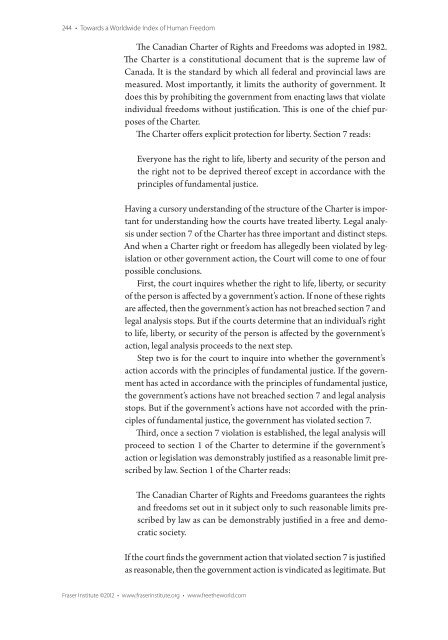Towards a Worldwide Index of Human Freedom
Towards a Worldwide Index of Human Freedom
Towards a Worldwide Index of Human Freedom
Create successful ePaper yourself
Turn your PDF publications into a flip-book with our unique Google optimized e-Paper software.
244 • <strong>Towards</strong> a <strong>Worldwide</strong> <strong>Index</strong> <strong>of</strong> <strong>Human</strong> <strong>Freedom</strong><br />
The Canadian Charter <strong>of</strong> Rights and <strong>Freedom</strong>s was adopted in 1982.<br />
The Charter is a constitutional document that is the supreme law <strong>of</strong><br />
Canada. It is the standard by which all federal and provincial laws are<br />
measured. Most importantly, it limits the authority <strong>of</strong> government. It<br />
does this by prohibiting the government from enacting laws that violate<br />
individual freedoms without justification. This is one <strong>of</strong> the chief purposes<br />
<strong>of</strong> the Charter.<br />
The Charter <strong>of</strong>fers explicit protection for liberty. Section 7 reads:<br />
Everyone has the right to life, liberty and security <strong>of</strong> the person and<br />
the right not to be deprived there<strong>of</strong> except in accordance with the<br />
principles <strong>of</strong> fundamental justice.<br />
Having a cursory understanding <strong>of</strong> the structure <strong>of</strong> the Charter is important<br />
for understanding how the courts have treated liberty. Legal analysis<br />
under section 7 <strong>of</strong> the Charter has three important and distinct steps.<br />
And when a Charter right or freedom has allegedly been violated by legislation<br />
or other government action, the Court will come to one <strong>of</strong> four<br />
possible conclusions.<br />
First, the court inquires whether the right to life, liberty, or security<br />
<strong>of</strong> the person is affected by a government’s action. If none <strong>of</strong> these rights<br />
are affected, then the government’s action has not breached section 7 and<br />
legal analysis stops. But if the courts determine that an individual’s right<br />
to life, liberty, or security <strong>of</strong> the person is affected by the government’s<br />
action, legal analysis proceeds to the next step.<br />
Step two is for the court to inquire into whether the government’s<br />
action accords with the principles <strong>of</strong> fundamental justice. If the government<br />
has acted in accordance with the principles <strong>of</strong> fundamental justice,<br />
the government’s actions have not breached section 7 and legal analysis<br />
stops. But if the government’s actions have not accorded with the principles<br />
<strong>of</strong> fundamental justice, the government has violated section 7.<br />
Third, once a section 7 violation is established, the legal analysis will<br />
proceed to section 1 <strong>of</strong> the Charter to determine if the government’s<br />
action or legislation was demonstrably justified as a reasonable limit prescribed<br />
by law. Section 1 <strong>of</strong> the Charter reads:<br />
The Canadian Charter <strong>of</strong> Rights and <strong>Freedom</strong>s guarantees the rights<br />
and freedoms set out in it subject only to such reasonable limits prescribed<br />
by law as can be demonstrably justified in a free and democratic<br />
society.<br />
If the court finds the government action that violated section 7 is justified<br />
as reasonable, then the government action is vindicated as legitimate. But<br />
Fraser Institute ©2012 • www.fraserinstitute.org • www.freetheworld.com


